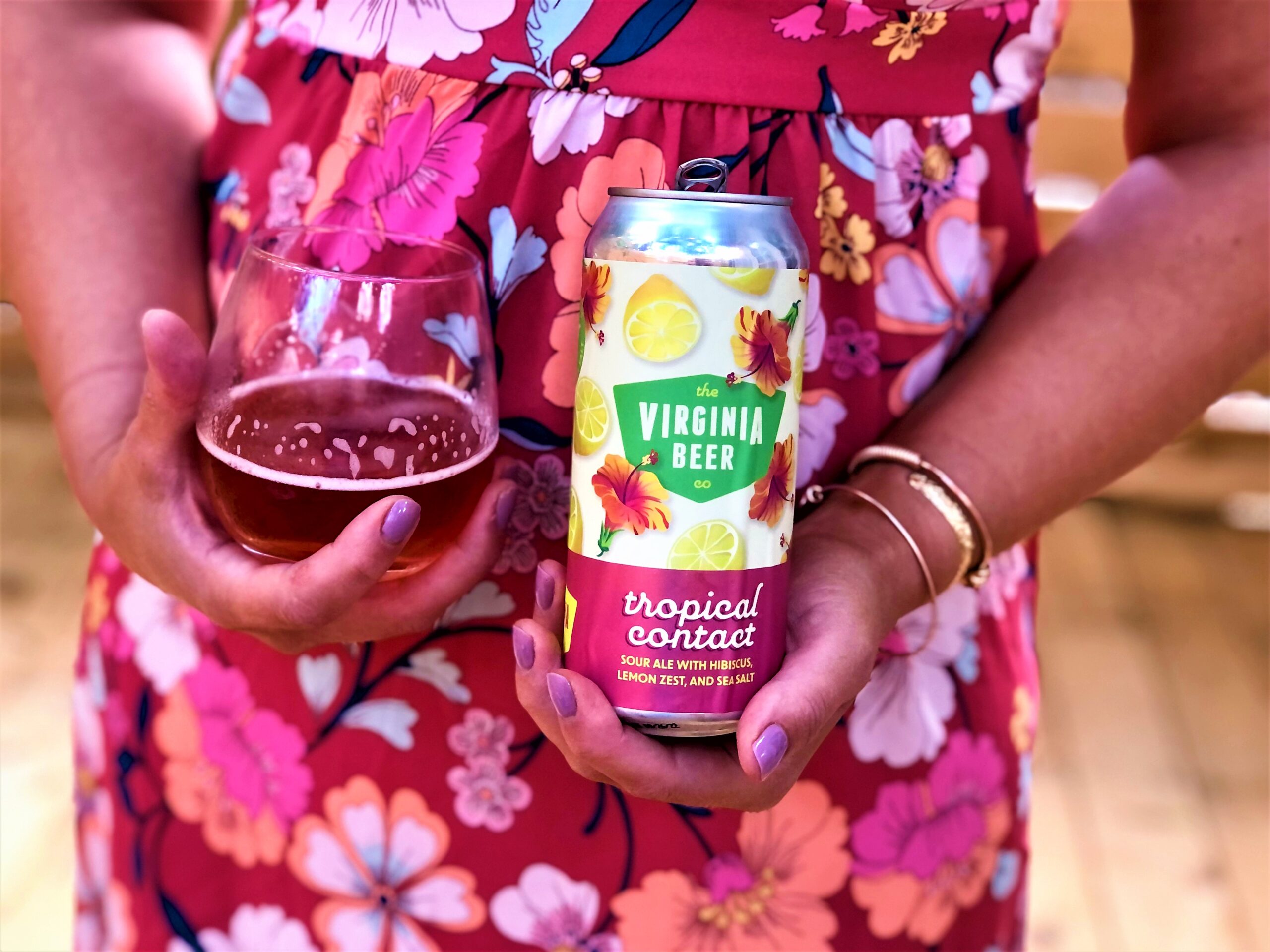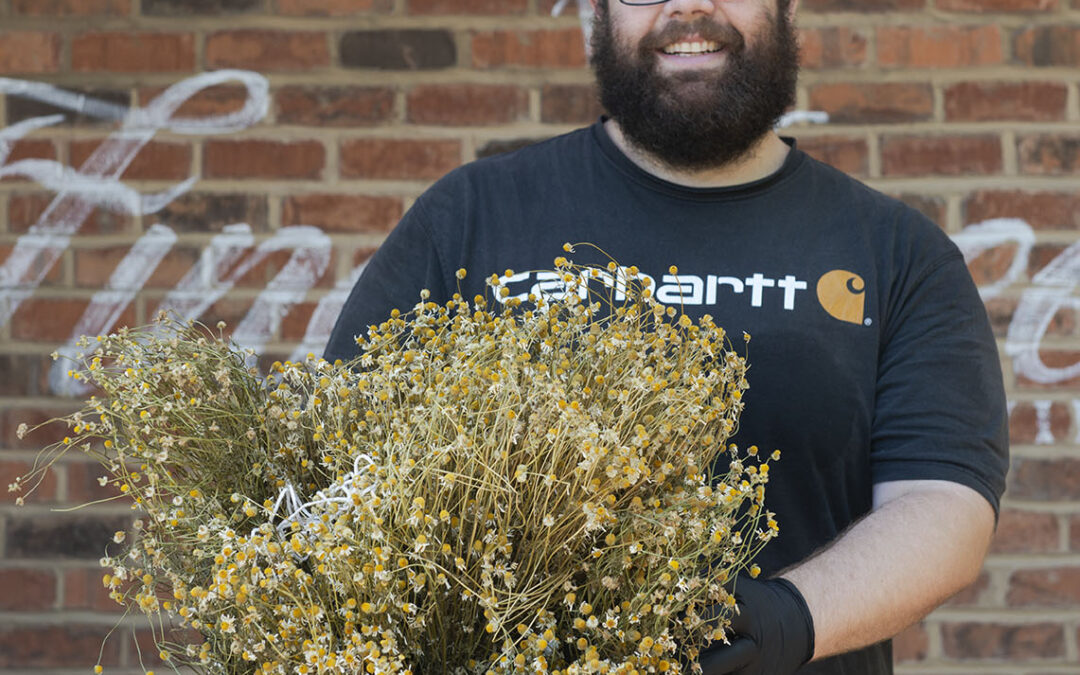(Fine Creek head brewer Brian Mandeville with fresh chamomile)
By Chris Cook
If April showers bring May flowers, they also help Virginia brewers produce some unique brews across the Commonwealth.
While the almighty hop is a flower itself and the undisputed king of the global beer market, Virginia’s craft breweries are pushing the boundaries of ex-beer-imentation with floral ingredients that in some cases come right from their own backyards. From the signature pink hues leached from hibiscus petals to the complex flavors and aromas imparted by chamomile and magnolia blossoms, Virginia beer is embracing the power of the flower.
Fine Creek Brewing has taken advantage of Virginia’s agricultural prowess with a farm-to-table approach using locally sourced ingredients, including juniper, pine, yarrow and, his personal favorite, Fine Creek’s own fresh chamomile. Head brewer Brian Mandeville and his staff plant the chamomile specifically for brewing, allowing for regular experimentation in a number of recipes.
“Chamomile is easy to preserve, and it has this great kind of grassy, floral, almost honey tone, maybe even leaning towards pear at times,” Mandeville said. “It has this great array of flavor depending on how you use it.”
Mandeville has infused chamomile in a variety of ways, adding it to a number of Fine Creek’s styles, including a wit and a saison. Later in the spring, he says Fine Creek will re-release and bottle a chamomile-conditioned saison fermented with brettanomyces that has long been a fan favorite – and a brewer favorite.
Unique flavors aren’t the only characteristics flowers can add to a beer, though, as Hardywood Brewing in Richmond and Adroit Theory Brewing in Purcellville have shown.
Hardywood has actually seen one of its signature offerings, Tropic Like It’s Hot, evolve by swapping out the recipe’s original butterfly pea flower for hibiscus petals. In its debut form, the fruited sour took on a deep purple from the blue-tinted butterfly pea, providing an eye-catching aesthetic for the annual release that is brewed in collaboration with Virginia Pride.
However, due to the difficulty in procuring enough butterfly pea flowers, Hardywood brewmaster Brian Nelson swapped out one flower for another.
“Originally we used butterfly pea flowers just to get some color and some background dryness,” Nelson said. “That changed over to hibiscus flower because butterfly peas were hard to get. It was a fun experiment, and the hibiscus goes well with the sour.”
The result was a minor but noticeable change in Tropic Like It’s Hot’s color due to the red hibiscus, but a similar synergistic gustation with the passionfruit, pineapple and blueberry that provides the beer’s foundation.
Like Hardywood, flowers aren’t a regular ingredient in Adroit Theory’s offerings, but – says founder and owner Mark Osborne – they have produced some of the brewery’s most interesting beers. Known for experimentation and doing “wackadoodle things in the brewhouse,” Adroit Theory has used a variety of flowers and flower-based adjuncts over the years, including birch water, hibiscus, jasmine, Japanese cherry blossoms and orange blossoms.
Used in Belgians like Potion of Healing and Perfect Blossom, saisons like Persona Non Grata, and even IPAs, those ingredients have provided Adroit Theory’s beers unique characteristics from florality to earthiness, fruitiness and bitterness that Osborne credits entirely to the flowers.
“Persona Non Grata is a very simple two-style saison, but the addition of hibiscus adds kind of a rosé color to it,” he said. “It has a very distinct taste because of the hibiscus. Perfect Blossom had a very light and neutral base, and then jasmine has a very distinct flavor and the cherry blossom contributed a very floral note that otherwise wouldn’t have been there.”
But Osborne pointed out another challenge brewers face when using flower-related adjuncts, namely some consumers’ unfamiliarity with the ingredients.
“There are definitely people that are into those ingredients, that multi-layered approach with that type of beer,” he said. “But it’s very niche. People will give anything a try, but wanting to buy it again once they’ve tasted it is a bit of a hard sell. Potion of Healing was a really interesting beer, I would say one of the top five most interesting beers we’ve ever made, but maybe only three percent of our fanbase would appreciate it and buy it again.”

(Everything comes up red by using hibiscus in beer like this beauty from The Virginia Beer Company)
However, when brewers hit on the right flower-inspired recipe, beer drinkers can flock to the taproom like bees to a blossom. Such has been the case with Virginia Beer Company’s Tropical Contact, a sour ale brewed with hibiscus, lemon zest and sea salt that will be the brewery’s spring season for statewide distribution.
“The beer is just killer,” said Jonathan Newman, brewmaster at the Williamsburg-based Virginia Beer Company. “We’ve done it a few times on the five-barrel pilot scale, but it’s done so well in the taproom that we’re scaling it up for statewide distribution this spring.”
Hibiscus petals have appeared in a number of Virginia Beer Company’s beers since opening in 2016, including sours, Belgians, and a pink-hued golden ale called “Here For The Girls.” Virginia Beer Company donates 20 percent of gross sales from Here For The Girls to the charitable organization of the same name, whose mission is to improve the lives of young women and family members affected by breast cancer.
“I love using hibiscus. It’s just a really fun ingredient,” Newman added. “It has a couple different aspects to it. There’s the color change, which is striking in the glass. Then there’s a floral characteristic, of course, but it’s also got a kind of tartness to it and a little bit of bitterness. The best comparison that comes to mind for me personally is cranberry.”
That flowers can bring aromas and flavors to beer that are more than simply “floral” is also apparent in a number of distinctive beers made by Chincoteague’s Black Narrows Brewing. Influenced by a palette refined during his pre-brewing days as a chef, owner and head brewer Josh Chapman has taken a number of common blooms around the Virginia island and used them to concoct several signature brews.
Among those is Bull Bay, a brett table beer made with magnolia blossoms; Little Beach, a wheat beer made with crimson clover flowers; and Hope and Hibiscus, a fruited sour made with hibiscus petals. He gets his crimson clover, hibiscus and magnolia blossoms from local providers, which ensures that he’s using the freshest ingredients on brew day while also supporting local farmers and business owners.
However, the wild aromas of what grows out of the ground aren’t always what pours out of the tap, as Chapman has learned since opening Black Narrows in late 2017.
“When we first found the crimson clover, my wife picked a flower head, rubbed it between her palms and said ‘You have to smell this,’” Chapman said. “It smelled like this super vibrant, fresh cucumber. But when we took it back to dry them out, the drying process drastically changed how they impacted the beer. They ended up losing some of the cucumber and gaining this really big strawberry Fruit Roll-Up flavor.”
The same phenomenon occurs regularly with Bull Bay, which requires Chapman to load up an iced cooler with magnolia blossoms and drive them back to the brewery before the petals begin to wilt. The result is worth the trouble, he says, as the fresh blossoms give Bull Bay a flavor that is among the most unique consumers can find in the Commonwealth.
“There’s definitely a big, vibrant florality,” Chapman said. “But Bull Bay is mixed fermentation and there’s some funk to it, so the magnolia pulls the tropical florality out of the brettanomyces. There’s also almost like a perceived sweetness, akin to honeysuckle. There’s an insinuation of nectar. That’s really cool to have in a mixed-ferm beer because it’s so dry, so having this aromatic honey-hive sweetness was an added bonus.”



